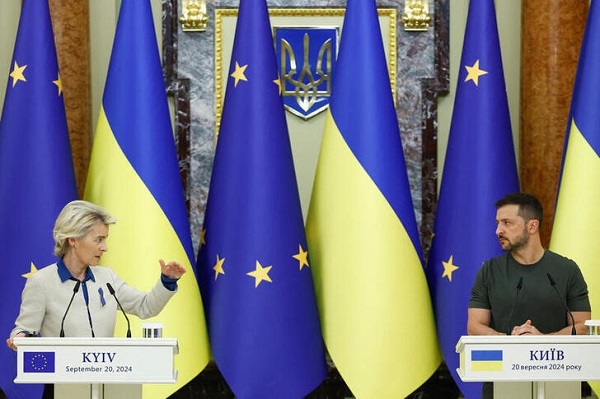 European Commission President Ursula Von der Leyen and Ukraine's President Volodymyr Zelensky attend a joint press conference in Kyiv, Ukraine, 20 September 2024;
Credit: Reuters/Valentyn Ogirenko/File Photo
European Commission President Ursula Von der Leyen and Ukraine's President Volodymyr Zelensky attend a joint press conference in Kyiv, Ukraine, 20 September 2024;
Credit: Reuters/Valentyn Ogirenko/File Photo
BRUSSELS (Reuters) - On Wednesday 9 October 2024, EU envoys agreed to give Ukraine up to €35 billion as part of the bloc's share in a larger planned loan from the Group of Seven nations (G7) backed by frozen Russian central bank assets, a statement from the Council of the EU said.
The G7 and European Union announced in June 2024 that they would provide a $50 billion loan to help Ukraine, serviced by profits generated by Russian assets immobilised in the West. These assets were frozen shortly after Russia launched a full-scale invasion of Ukraine in February 2022.
More than two thirds of the assets, some €210 billion, are stuck in the 27-nation EU and of those, most are held by Belgium's depository Euroclear.
With Wednesday's accord, the EU can rely on headroom in its budget as a guarantee in case the restrictions on the assets are lifted. All of the EU's sanctions on Moscow must be renewed every six months via a unanimous EU vote. But Hungary, with its Russia-friendly stance, has repeatedly tried to block sanctions and measures to help Ukraine, and could halt a renewal.
Hungary - which holds the six-month rotating EU presidency - does not want to discuss any possible extension for the regime holding the assets until after the US election in early November 2024.
The European Commission proposed extending the renewal period from six to 36 months but Hungary did not table the proposal during envoy discussions, EU diplomats said.
The Commission's loan proposal also needs to be approved by the European Parliament as it involves the bloc's budget. EU lawmakers are expected to vote on the package on 22 October 2024, diplomats said.
The agreement helps bypass Hungary's refusal to extend the renewal period. The loan, an "exceptional macro-financial assistance (MFA)", was able to pass quickly as the measure only required a qualified majority vote rather than unanimity.
"The aim is to make the MFA loan available in 2024, with disbursement in 2025, to be repaid over a maximum period of 45 years," the council statement said.
The deal will not be enough to reassure the US, however. Washington initially agreed to contribute some $20 billion but does not want to move forward without assurances that the Russian assets will remain frozen for longer.








